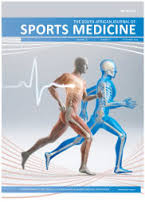Neuroimaging in contact sports: Determining brain fitness before and after a bout
DOI:
https://doi.org/10.17159/2078-516X/2017/v29i1a3235Abstract
Background: Professional boxing and mixed martial arts (MMA) are popular contact sports with high risk for both acute and chronic traumatic brain injury (TBI). Although rare, combatants have died in the ring/cage or soon after the completion of the bout. The cause of death in these cases is usually acute subdural hematoma, acute epidural hematoma, subarachnoid haemorrhage, intracranial haemorrhage, or second-impact syndrome (SIS). Neuroimaging or brain imaging is currently included in the process of registering for a license to fight in a combat sport in most states in the United States and around the world. However, the required imaging specifics and frequency vary.
Discussion: Neuroimaging serves two distinct roles in the individualised care of a combatant, representing a step towards personalised medicine and individual risk stratification. Neuroimaging prior to licensure helps to identify and/or exclude coincidental or clinically suspected brain lesions which may pose a risk for rupture, bleeding or other catastrophic and important brain injury. Neuroimaging in the immediate aftermath of a bout primarily serves to rule out acute traumatic brain injury. Neuroimaging may also be carried out to assess for evidence of structural brain injury which may make a combatant more likely to express late-life neuropsychiatric sequelae of brain injury, such as chronic traumatic encephalopathy. As such, neuroimaging plays a prognostic role and aids in the determination of whether the combatant should be allowed to continue to participate in future bouts or not.
Conclusion: Currently there are no established neuroimaging guidelines for contact sports. Standardising neuroimaging guidelines both for licensure as well as neuroimaging modality, and protocols to assess for both acute and chronic traumatic brain injury. This will assist in protecting the combatant’s health and safety, both in the ring/cage, and after their professional careers have ended. Some suggested guidelines are provided based on currently available medical literature. It is recommended that these guidelines be debated vigorously by the scientific community and that evidence-based guidelines be developed by the medical community in conjunction with professional boxing and MMA governing bodies.
Downloads
Downloads
Published
Issue
Section
License
Copyright (c) 2017 South African Journal of Sports Medicine

This work is licensed under a Creative Commons Attribution 4.0 International License.
The South African Journal of Sports Medicine reserves copyright of the material published. The work is licensed under a Creative Commons Attribution 4.0 (CC BY 4.0) International License. Material submitted for publication in the South African Journal of Sports Medicine is accepted provided it has not been published elsewhere. The South African Journal of Sports Medicine does not hold itself responsible for statements made by the authors.
How to Cite
- Abstract 352
- PDF 353





.png)